Strategies for Developing People and High Performance Organizations
VerifiedAdded on 2019/10/30
|8
|2101
|371
Essay
AI Summary
This essay delves into the crucial role of Human Resource Development (HRD) in fostering high-performance organizations. It emphasizes the need for organizations to develop core competencies and innovative capabilities to thrive in a competitive global landscape. The essay highlights the shift towards strategic human resource management, where HR practices are aligned with organizational objectives to achieve economic goals, employee satisfaction, and social legitimacy. It explores the importance of assessing current HRM policies, identifying gaps in human resources, and developing strategies to generate competitive advantage. The paper also discusses the four stages of HRD management: investigation, design, implementation, and evaluation. The essay concludes by underscoring the significance of a strategically aligned approach to HRD in driving organizational success and competitive advantage, stressing that the knowledge within an organization's human capital can emerge as a root of all the competitive advantages. It also touches upon the challenges faced by HRD professionals and the proactive nature of HR managers within an organization.
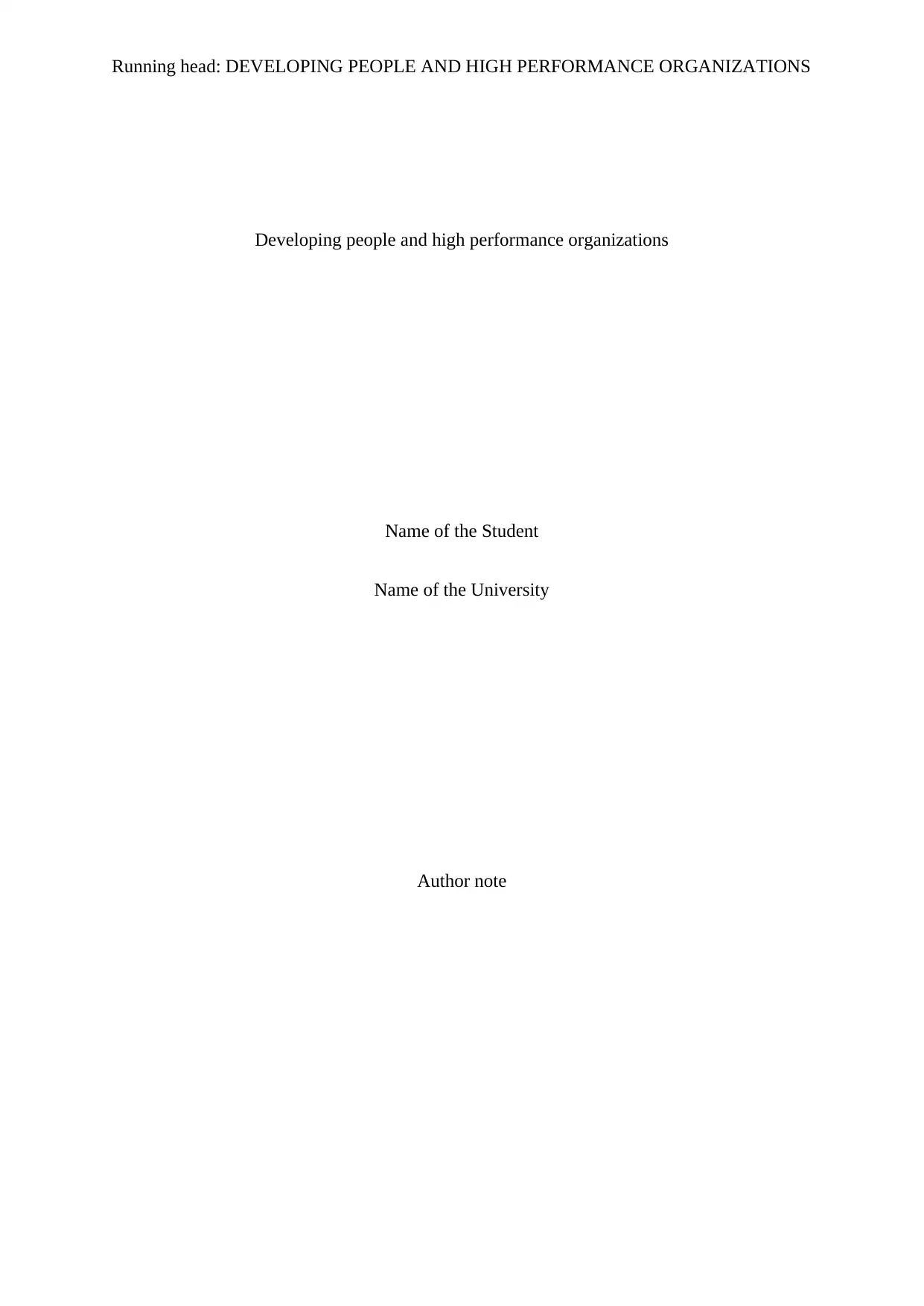
Running head: DEVELOPING PEOPLE AND HIGH PERFORMANCE ORGANIZATIONS
Developing people and high performance organizations
Name of the Student
Name of the University
Author note
Developing people and high performance organizations
Name of the Student
Name of the University
Author note
Paraphrase This Document
Need a fresh take? Get an instant paraphrase of this document with our AI Paraphraser
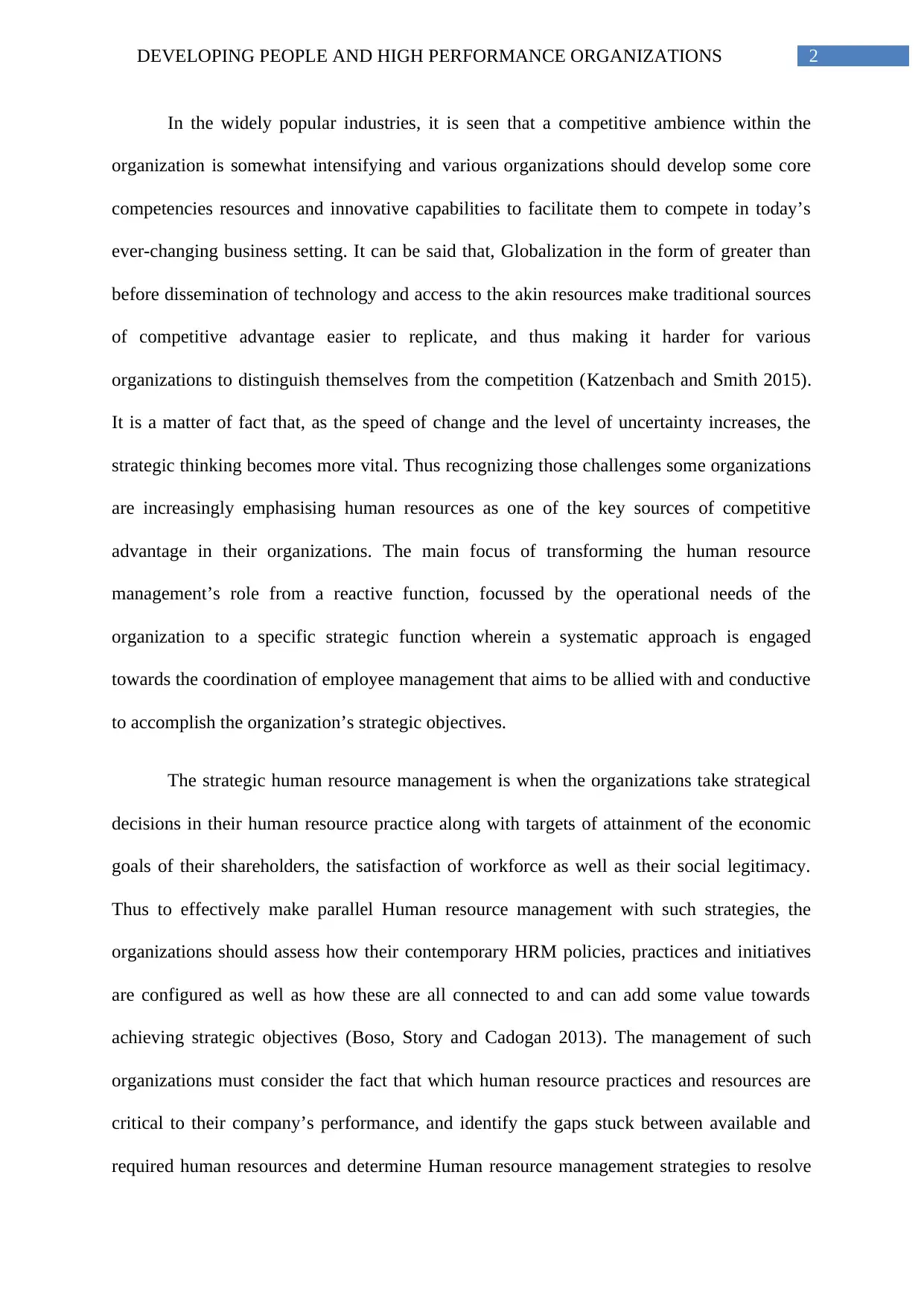
2DEVELOPING PEOPLE AND HIGH PERFORMANCE ORGANIZATIONS
In the widely popular industries, it is seen that a competitive ambience within the
organization is somewhat intensifying and various organizations should develop some core
competencies resources and innovative capabilities to facilitate them to compete in today’s
ever-changing business setting. It can be said that, Globalization in the form of greater than
before dissemination of technology and access to the akin resources make traditional sources
of competitive advantage easier to replicate, and thus making it harder for various
organizations to distinguish themselves from the competition (Katzenbach and Smith 2015).
It is a matter of fact that, as the speed of change and the level of uncertainty increases, the
strategic thinking becomes more vital. Thus recognizing those challenges some organizations
are increasingly emphasising human resources as one of the key sources of competitive
advantage in their organizations. The main focus of transforming the human resource
management’s role from a reactive function, focussed by the operational needs of the
organization to a specific strategic function wherein a systematic approach is engaged
towards the coordination of employee management that aims to be allied with and conductive
to accomplish the organization’s strategic objectives.
The strategic human resource management is when the organizations take strategical
decisions in their human resource practice along with targets of attainment of the economic
goals of their shareholders, the satisfaction of workforce as well as their social legitimacy.
Thus to effectively make parallel Human resource management with such strategies, the
organizations should assess how their contemporary HRM policies, practices and initiatives
are configured as well as how these are all connected to and can add some value towards
achieving strategic objectives (Boso, Story and Cadogan 2013). The management of such
organizations must consider the fact that which human resource practices and resources are
critical to their company’s performance, and identify the gaps stuck between available and
required human resources and determine Human resource management strategies to resolve
In the widely popular industries, it is seen that a competitive ambience within the
organization is somewhat intensifying and various organizations should develop some core
competencies resources and innovative capabilities to facilitate them to compete in today’s
ever-changing business setting. It can be said that, Globalization in the form of greater than
before dissemination of technology and access to the akin resources make traditional sources
of competitive advantage easier to replicate, and thus making it harder for various
organizations to distinguish themselves from the competition (Katzenbach and Smith 2015).
It is a matter of fact that, as the speed of change and the level of uncertainty increases, the
strategic thinking becomes more vital. Thus recognizing those challenges some organizations
are increasingly emphasising human resources as one of the key sources of competitive
advantage in their organizations. The main focus of transforming the human resource
management’s role from a reactive function, focussed by the operational needs of the
organization to a specific strategic function wherein a systematic approach is engaged
towards the coordination of employee management that aims to be allied with and conductive
to accomplish the organization’s strategic objectives.
The strategic human resource management is when the organizations take strategical
decisions in their human resource practice along with targets of attainment of the economic
goals of their shareholders, the satisfaction of workforce as well as their social legitimacy.
Thus to effectively make parallel Human resource management with such strategies, the
organizations should assess how their contemporary HRM policies, practices and initiatives
are configured as well as how these are all connected to and can add some value towards
achieving strategic objectives (Boso, Story and Cadogan 2013). The management of such
organizations must consider the fact that which human resource practices and resources are
critical to their company’s performance, and identify the gaps stuck between available and
required human resources and determine Human resource management strategies to resolve
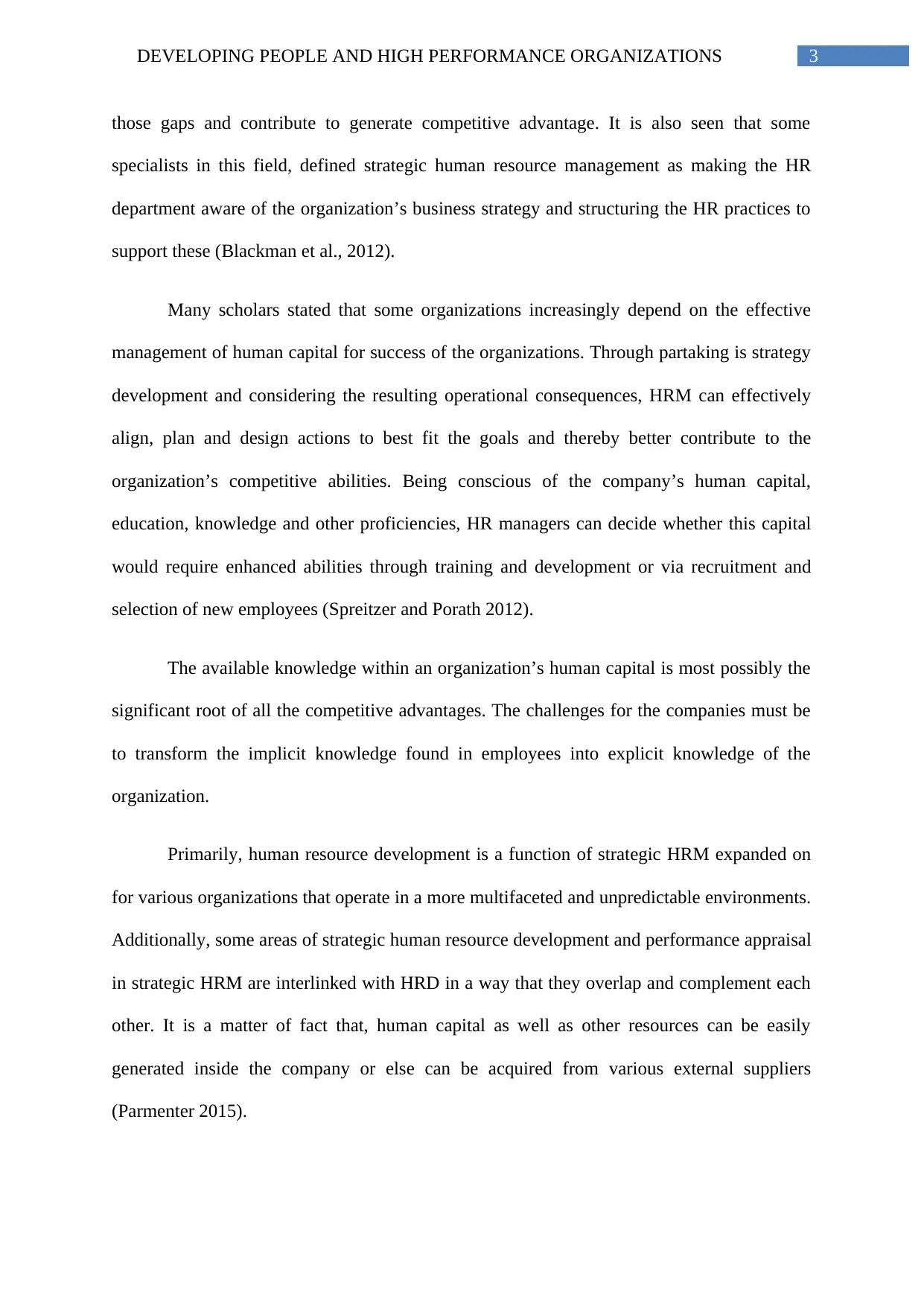
3DEVELOPING PEOPLE AND HIGH PERFORMANCE ORGANIZATIONS
those gaps and contribute to generate competitive advantage. It is also seen that some
specialists in this field, defined strategic human resource management as making the HR
department aware of the organization’s business strategy and structuring the HR practices to
support these (Blackman et al., 2012).
Many scholars stated that some organizations increasingly depend on the effective
management of human capital for success of the organizations. Through partaking is strategy
development and considering the resulting operational consequences, HRM can effectively
align, plan and design actions to best fit the goals and thereby better contribute to the
organization’s competitive abilities. Being conscious of the company’s human capital,
education, knowledge and other proficiencies, HR managers can decide whether this capital
would require enhanced abilities through training and development or via recruitment and
selection of new employees (Spreitzer and Porath 2012).
The available knowledge within an organization’s human capital is most possibly the
significant root of all the competitive advantages. The challenges for the companies must be
to transform the implicit knowledge found in employees into explicit knowledge of the
organization.
Primarily, human resource development is a function of strategic HRM expanded on
for various organizations that operate in a more multifaceted and unpredictable environments.
Additionally, some areas of strategic human resource development and performance appraisal
in strategic HRM are interlinked with HRD in a way that they overlap and complement each
other. It is a matter of fact that, human capital as well as other resources can be easily
generated inside the company or else can be acquired from various external suppliers
(Parmenter 2015).
those gaps and contribute to generate competitive advantage. It is also seen that some
specialists in this field, defined strategic human resource management as making the HR
department aware of the organization’s business strategy and structuring the HR practices to
support these (Blackman et al., 2012).
Many scholars stated that some organizations increasingly depend on the effective
management of human capital for success of the organizations. Through partaking is strategy
development and considering the resulting operational consequences, HRM can effectively
align, plan and design actions to best fit the goals and thereby better contribute to the
organization’s competitive abilities. Being conscious of the company’s human capital,
education, knowledge and other proficiencies, HR managers can decide whether this capital
would require enhanced abilities through training and development or via recruitment and
selection of new employees (Spreitzer and Porath 2012).
The available knowledge within an organization’s human capital is most possibly the
significant root of all the competitive advantages. The challenges for the companies must be
to transform the implicit knowledge found in employees into explicit knowledge of the
organization.
Primarily, human resource development is a function of strategic HRM expanded on
for various organizations that operate in a more multifaceted and unpredictable environments.
Additionally, some areas of strategic human resource development and performance appraisal
in strategic HRM are interlinked with HRD in a way that they overlap and complement each
other. It is a matter of fact that, human capital as well as other resources can be easily
generated inside the company or else can be acquired from various external suppliers
(Parmenter 2015).
⊘ This is a preview!⊘
Do you want full access?
Subscribe today to unlock all pages.

Trusted by 1+ million students worldwide
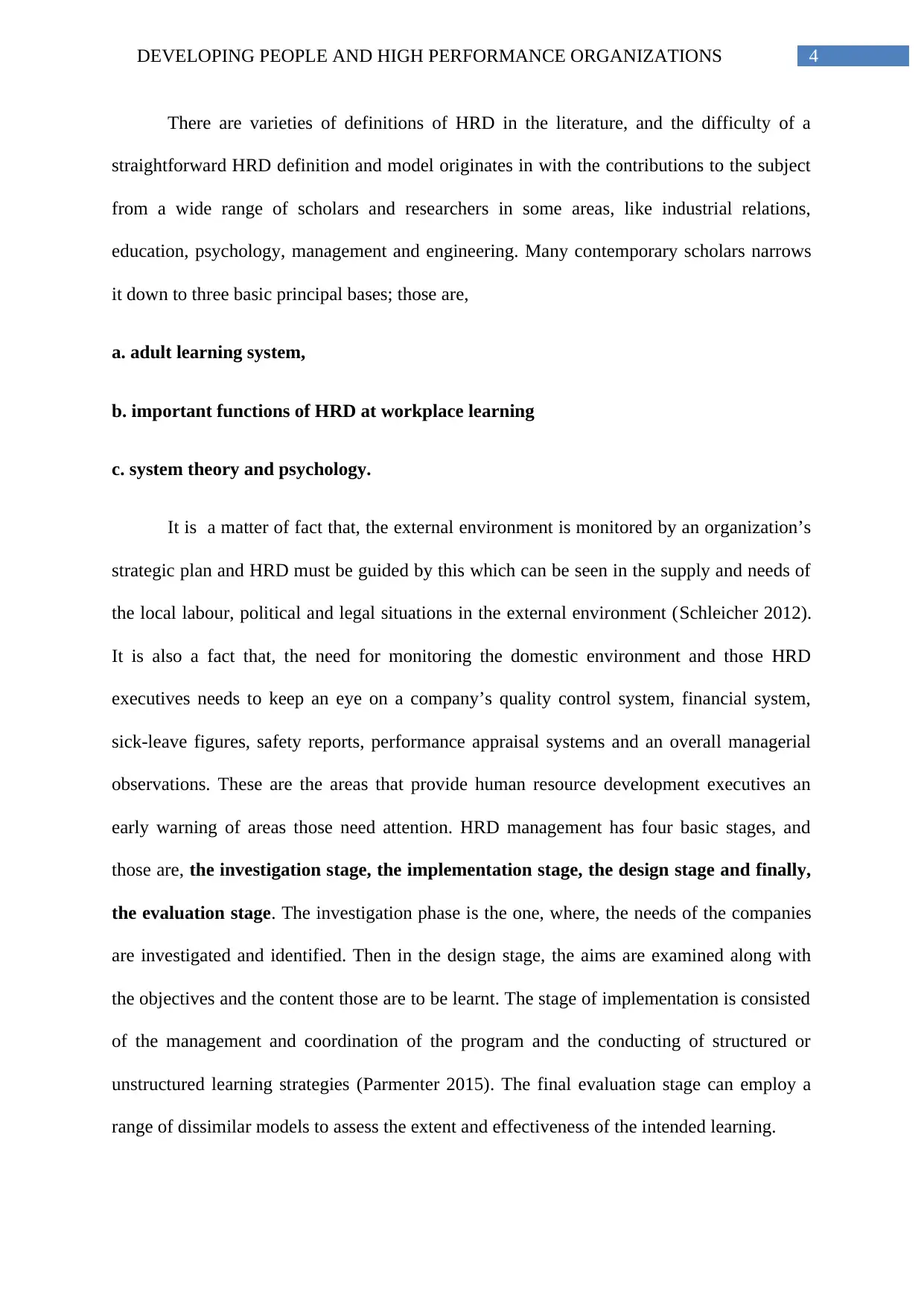
4DEVELOPING PEOPLE AND HIGH PERFORMANCE ORGANIZATIONS
There are varieties of definitions of HRD in the literature, and the difficulty of a
straightforward HRD definition and model originates in with the contributions to the subject
from a wide range of scholars and researchers in some areas, like industrial relations,
education, psychology, management and engineering. Many contemporary scholars narrows
it down to three basic principal bases; those are,
a. adult learning system,
b. important functions of HRD at workplace learning
c. system theory and psychology.
It is a matter of fact that, the external environment is monitored by an organization’s
strategic plan and HRD must be guided by this which can be seen in the supply and needs of
the local labour, political and legal situations in the external environment (Schleicher 2012).
It is also a fact that, the need for monitoring the domestic environment and those HRD
executives needs to keep an eye on a company’s quality control system, financial system,
sick-leave figures, safety reports, performance appraisal systems and an overall managerial
observations. These are the areas that provide human resource development executives an
early warning of areas those need attention. HRD management has four basic stages, and
those are, the investigation stage, the implementation stage, the design stage and finally,
the evaluation stage. The investigation phase is the one, where, the needs of the companies
are investigated and identified. Then in the design stage, the aims are examined along with
the objectives and the content those are to be learnt. The stage of implementation is consisted
of the management and coordination of the program and the conducting of structured or
unstructured learning strategies (Parmenter 2015). The final evaluation stage can employ a
range of dissimilar models to assess the extent and effectiveness of the intended learning.
There are varieties of definitions of HRD in the literature, and the difficulty of a
straightforward HRD definition and model originates in with the contributions to the subject
from a wide range of scholars and researchers in some areas, like industrial relations,
education, psychology, management and engineering. Many contemporary scholars narrows
it down to three basic principal bases; those are,
a. adult learning system,
b. important functions of HRD at workplace learning
c. system theory and psychology.
It is a matter of fact that, the external environment is monitored by an organization’s
strategic plan and HRD must be guided by this which can be seen in the supply and needs of
the local labour, political and legal situations in the external environment (Schleicher 2012).
It is also a fact that, the need for monitoring the domestic environment and those HRD
executives needs to keep an eye on a company’s quality control system, financial system,
sick-leave figures, safety reports, performance appraisal systems and an overall managerial
observations. These are the areas that provide human resource development executives an
early warning of areas those need attention. HRD management has four basic stages, and
those are, the investigation stage, the implementation stage, the design stage and finally,
the evaluation stage. The investigation phase is the one, where, the needs of the companies
are investigated and identified. Then in the design stage, the aims are examined along with
the objectives and the content those are to be learnt. The stage of implementation is consisted
of the management and coordination of the program and the conducting of structured or
unstructured learning strategies (Parmenter 2015). The final evaluation stage can employ a
range of dissimilar models to assess the extent and effectiveness of the intended learning.
Paraphrase This Document
Need a fresh take? Get an instant paraphrase of this document with our AI Paraphraser
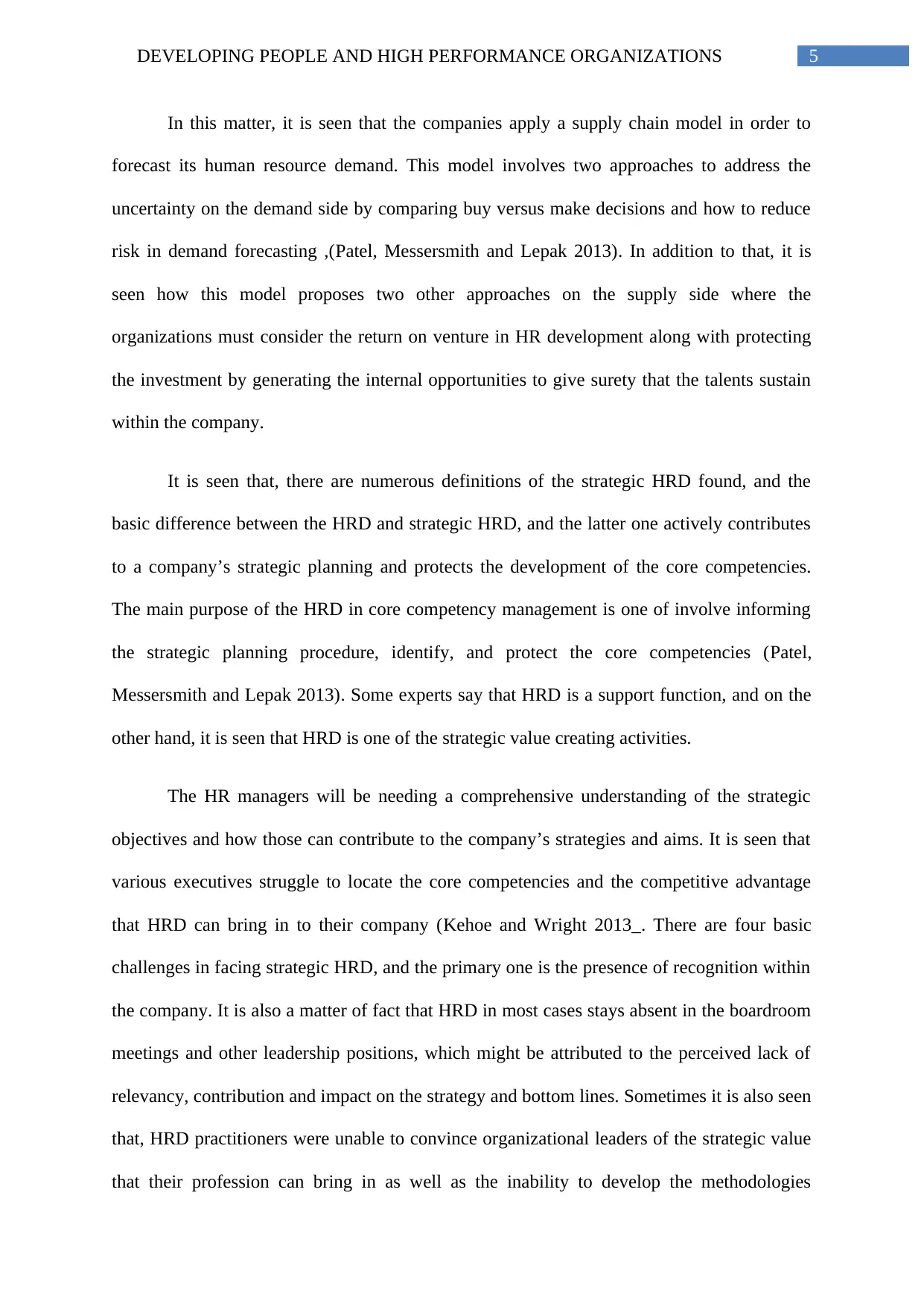
5DEVELOPING PEOPLE AND HIGH PERFORMANCE ORGANIZATIONS
In this matter, it is seen that the companies apply a supply chain model in order to
forecast its human resource demand. This model involves two approaches to address the
uncertainty on the demand side by comparing buy versus make decisions and how to reduce
risk in demand forecasting ,(Patel, Messersmith and Lepak 2013). In addition to that, it is
seen how this model proposes two other approaches on the supply side where the
organizations must consider the return on venture in HR development along with protecting
the investment by generating the internal opportunities to give surety that the talents sustain
within the company.
It is seen that, there are numerous definitions of the strategic HRD found, and the
basic difference between the HRD and strategic HRD, and the latter one actively contributes
to a company’s strategic planning and protects the development of the core competencies.
The main purpose of the HRD in core competency management is one of involve informing
the strategic planning procedure, identify, and protect the core competencies (Patel,
Messersmith and Lepak 2013). Some experts say that HRD is a support function, and on the
other hand, it is seen that HRD is one of the strategic value creating activities.
The HR managers will be needing a comprehensive understanding of the strategic
objectives and how those can contribute to the company’s strategies and aims. It is seen that
various executives struggle to locate the core competencies and the competitive advantage
that HRD can bring in to their company (Kehoe and Wright 2013_. There are four basic
challenges in facing strategic HRD, and the primary one is the presence of recognition within
the company. It is also a matter of fact that HRD in most cases stays absent in the boardroom
meetings and other leadership positions, which might be attributed to the perceived lack of
relevancy, contribution and impact on the strategy and bottom lines. Sometimes it is also seen
that, HRD practitioners were unable to convince organizational leaders of the strategic value
that their profession can bring in as well as the inability to develop the methodologies
In this matter, it is seen that the companies apply a supply chain model in order to
forecast its human resource demand. This model involves two approaches to address the
uncertainty on the demand side by comparing buy versus make decisions and how to reduce
risk in demand forecasting ,(Patel, Messersmith and Lepak 2013). In addition to that, it is
seen how this model proposes two other approaches on the supply side where the
organizations must consider the return on venture in HR development along with protecting
the investment by generating the internal opportunities to give surety that the talents sustain
within the company.
It is seen that, there are numerous definitions of the strategic HRD found, and the
basic difference between the HRD and strategic HRD, and the latter one actively contributes
to a company’s strategic planning and protects the development of the core competencies.
The main purpose of the HRD in core competency management is one of involve informing
the strategic planning procedure, identify, and protect the core competencies (Patel,
Messersmith and Lepak 2013). Some experts say that HRD is a support function, and on the
other hand, it is seen that HRD is one of the strategic value creating activities.
The HR managers will be needing a comprehensive understanding of the strategic
objectives and how those can contribute to the company’s strategies and aims. It is seen that
various executives struggle to locate the core competencies and the competitive advantage
that HRD can bring in to their company (Kehoe and Wright 2013_. There are four basic
challenges in facing strategic HRD, and the primary one is the presence of recognition within
the company. It is also a matter of fact that HRD in most cases stays absent in the boardroom
meetings and other leadership positions, which might be attributed to the perceived lack of
relevancy, contribution and impact on the strategy and bottom lines. Sometimes it is also seen
that, HRD practitioners were unable to convince organizational leaders of the strategic value
that their profession can bring in as well as the inability to develop the methodologies
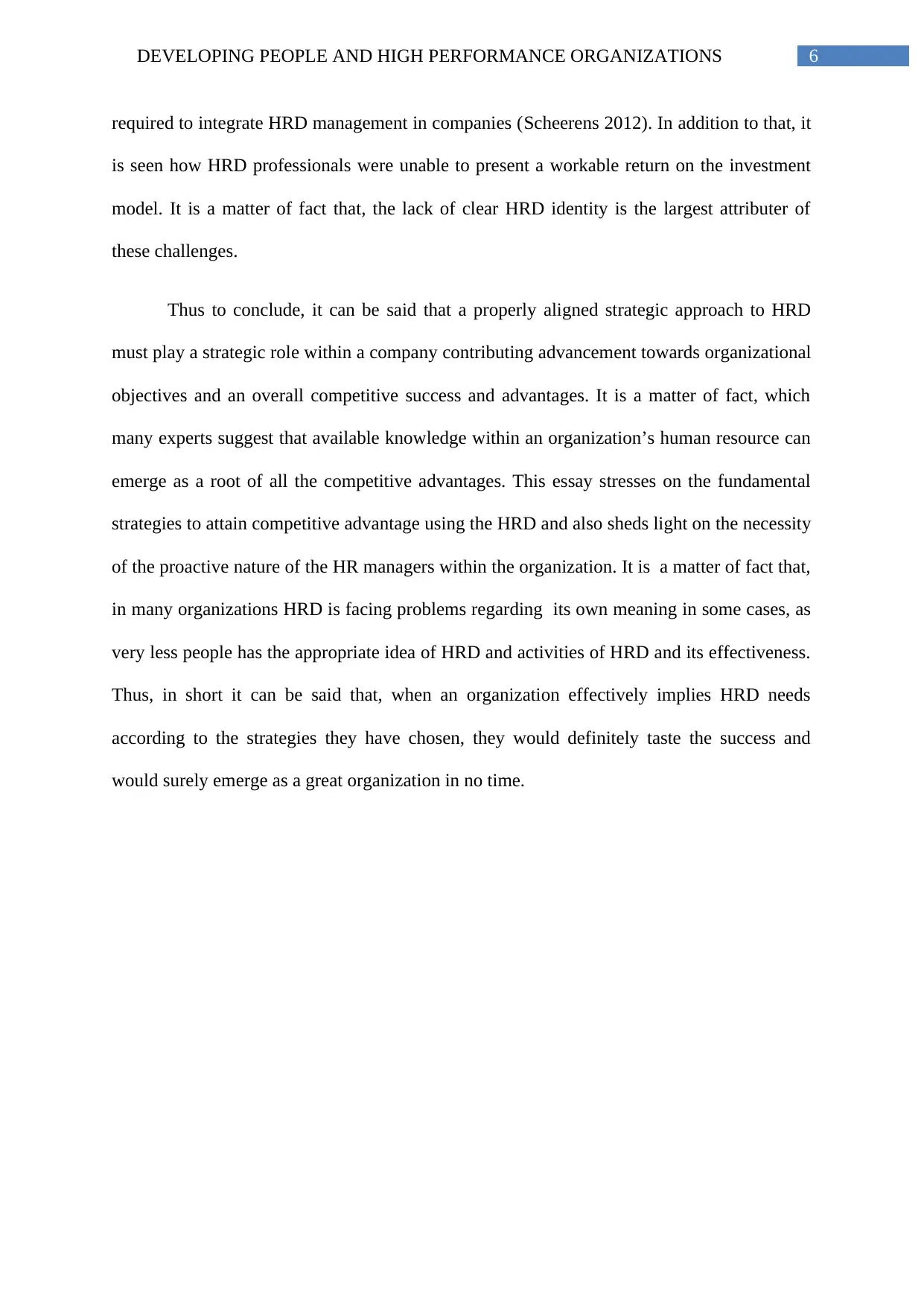
6DEVELOPING PEOPLE AND HIGH PERFORMANCE ORGANIZATIONS
required to integrate HRD management in companies (Scheerens 2012). In addition to that, it
is seen how HRD professionals were unable to present a workable return on the investment
model. It is a matter of fact that, the lack of clear HRD identity is the largest attributer of
these challenges.
Thus to conclude, it can be said that a properly aligned strategic approach to HRD
must play a strategic role within a company contributing advancement towards organizational
objectives and an overall competitive success and advantages. It is a matter of fact, which
many experts suggest that available knowledge within an organization’s human resource can
emerge as a root of all the competitive advantages. This essay stresses on the fundamental
strategies to attain competitive advantage using the HRD and also sheds light on the necessity
of the proactive nature of the HR managers within the organization. It is a matter of fact that,
in many organizations HRD is facing problems regarding its own meaning in some cases, as
very less people has the appropriate idea of HRD and activities of HRD and its effectiveness.
Thus, in short it can be said that, when an organization effectively implies HRD needs
according to the strategies they have chosen, they would definitely taste the success and
would surely emerge as a great organization in no time.
required to integrate HRD management in companies (Scheerens 2012). In addition to that, it
is seen how HRD professionals were unable to present a workable return on the investment
model. It is a matter of fact that, the lack of clear HRD identity is the largest attributer of
these challenges.
Thus to conclude, it can be said that a properly aligned strategic approach to HRD
must play a strategic role within a company contributing advancement towards organizational
objectives and an overall competitive success and advantages. It is a matter of fact, which
many experts suggest that available knowledge within an organization’s human resource can
emerge as a root of all the competitive advantages. This essay stresses on the fundamental
strategies to attain competitive advantage using the HRD and also sheds light on the necessity
of the proactive nature of the HR managers within the organization. It is a matter of fact that,
in many organizations HRD is facing problems regarding its own meaning in some cases, as
very less people has the appropriate idea of HRD and activities of HRD and its effectiveness.
Thus, in short it can be said that, when an organization effectively implies HRD needs
according to the strategies they have chosen, they would definitely taste the success and
would surely emerge as a great organization in no time.
⊘ This is a preview!⊘
Do you want full access?
Subscribe today to unlock all pages.

Trusted by 1+ million students worldwide
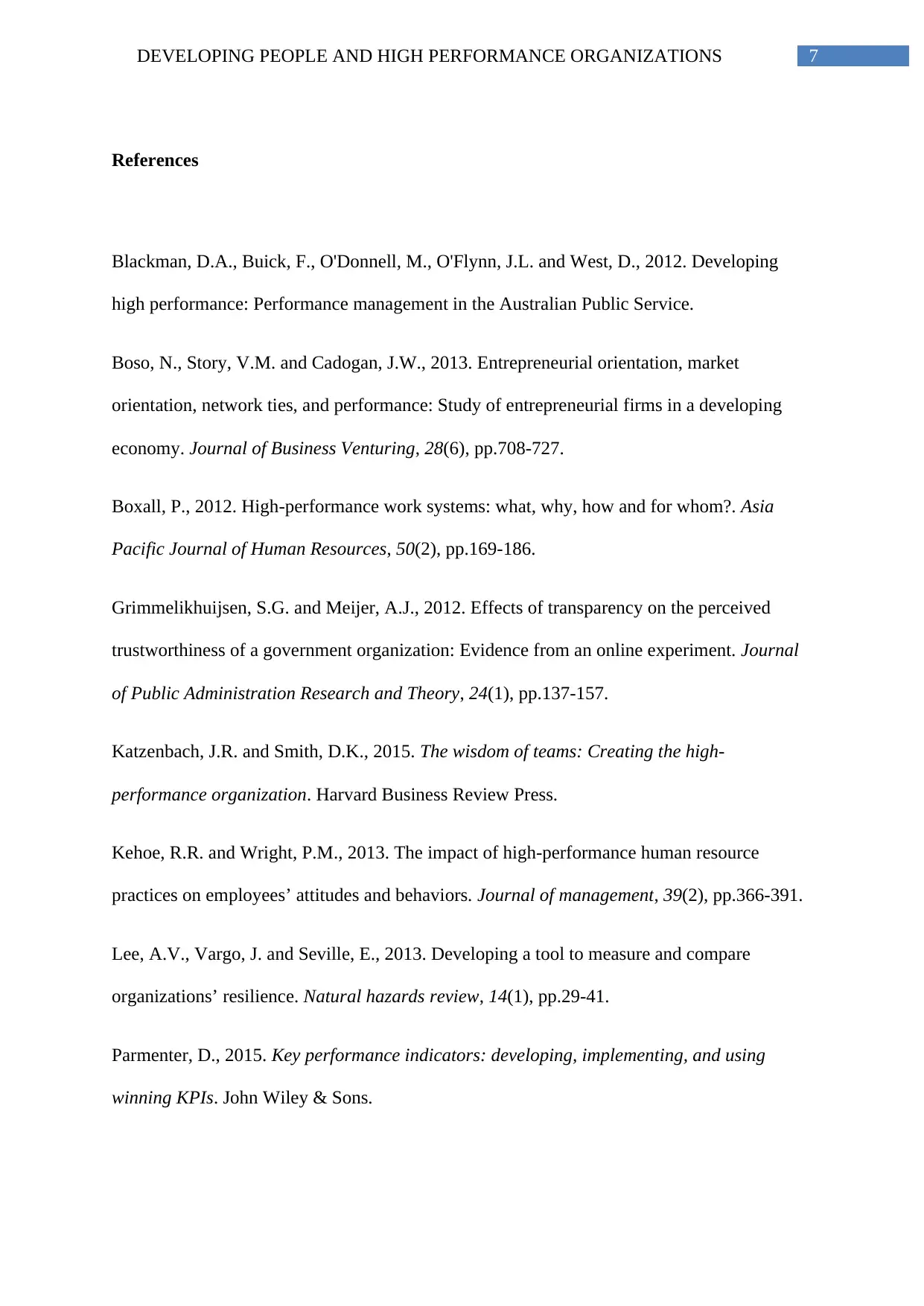
7DEVELOPING PEOPLE AND HIGH PERFORMANCE ORGANIZATIONS
References
Blackman, D.A., Buick, F., O'Donnell, M., O'Flynn, J.L. and West, D., 2012. Developing
high performance: Performance management in the Australian Public Service.
Boso, N., Story, V.M. and Cadogan, J.W., 2013. Entrepreneurial orientation, market
orientation, network ties, and performance: Study of entrepreneurial firms in a developing
economy. Journal of Business Venturing, 28(6), pp.708-727.
Boxall, P., 2012. High‐performance work systems: what, why, how and for whom?. Asia
Pacific Journal of Human Resources, 50(2), pp.169-186.
Grimmelikhuijsen, S.G. and Meijer, A.J., 2012. Effects of transparency on the perceived
trustworthiness of a government organization: Evidence from an online experiment. Journal
of Public Administration Research and Theory, 24(1), pp.137-157.
Katzenbach, J.R. and Smith, D.K., 2015. The wisdom of teams: Creating the high-
performance organization. Harvard Business Review Press.
Kehoe, R.R. and Wright, P.M., 2013. The impact of high-performance human resource
practices on employees’ attitudes and behaviors. Journal of management, 39(2), pp.366-391.
Lee, A.V., Vargo, J. and Seville, E., 2013. Developing a tool to measure and compare
organizations’ resilience. Natural hazards review, 14(1), pp.29-41.
Parmenter, D., 2015. Key performance indicators: developing, implementing, and using
winning KPIs. John Wiley & Sons.
References
Blackman, D.A., Buick, F., O'Donnell, M., O'Flynn, J.L. and West, D., 2012. Developing
high performance: Performance management in the Australian Public Service.
Boso, N., Story, V.M. and Cadogan, J.W., 2013. Entrepreneurial orientation, market
orientation, network ties, and performance: Study of entrepreneurial firms in a developing
economy. Journal of Business Venturing, 28(6), pp.708-727.
Boxall, P., 2012. High‐performance work systems: what, why, how and for whom?. Asia
Pacific Journal of Human Resources, 50(2), pp.169-186.
Grimmelikhuijsen, S.G. and Meijer, A.J., 2012. Effects of transparency on the perceived
trustworthiness of a government organization: Evidence from an online experiment. Journal
of Public Administration Research and Theory, 24(1), pp.137-157.
Katzenbach, J.R. and Smith, D.K., 2015. The wisdom of teams: Creating the high-
performance organization. Harvard Business Review Press.
Kehoe, R.R. and Wright, P.M., 2013. The impact of high-performance human resource
practices on employees’ attitudes and behaviors. Journal of management, 39(2), pp.366-391.
Lee, A.V., Vargo, J. and Seville, E., 2013. Developing a tool to measure and compare
organizations’ resilience. Natural hazards review, 14(1), pp.29-41.
Parmenter, D., 2015. Key performance indicators: developing, implementing, and using
winning KPIs. John Wiley & Sons.
Paraphrase This Document
Need a fresh take? Get an instant paraphrase of this document with our AI Paraphraser
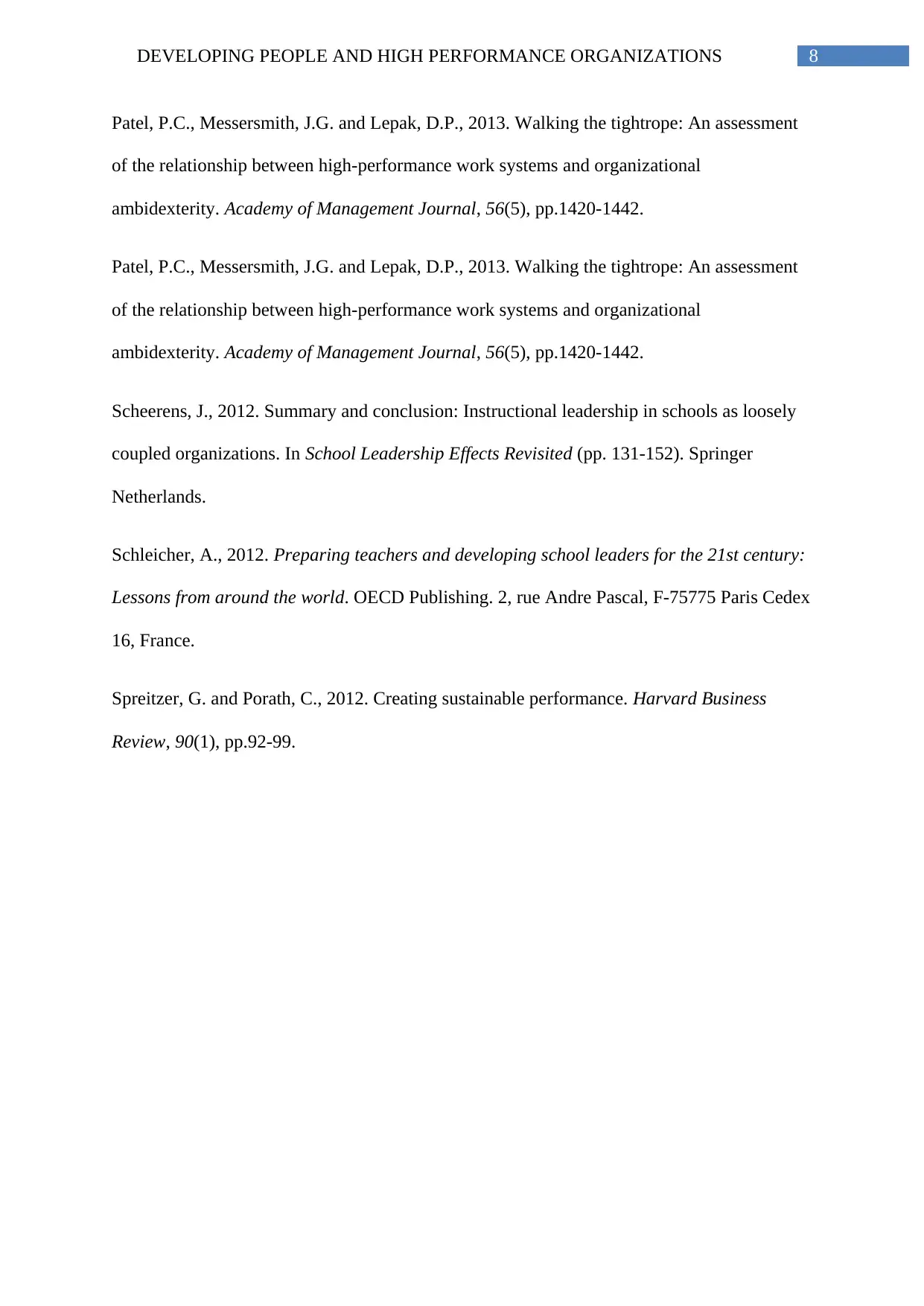
8DEVELOPING PEOPLE AND HIGH PERFORMANCE ORGANIZATIONS
Patel, P.C., Messersmith, J.G. and Lepak, D.P., 2013. Walking the tightrope: An assessment
of the relationship between high-performance work systems and organizational
ambidexterity. Academy of Management Journal, 56(5), pp.1420-1442.
Patel, P.C., Messersmith, J.G. and Lepak, D.P., 2013. Walking the tightrope: An assessment
of the relationship between high-performance work systems and organizational
ambidexterity. Academy of Management Journal, 56(5), pp.1420-1442.
Scheerens, J., 2012. Summary and conclusion: Instructional leadership in schools as loosely
coupled organizations. In School Leadership Effects Revisited (pp. 131-152). Springer
Netherlands.
Schleicher, A., 2012. Preparing teachers and developing school leaders for the 21st century:
Lessons from around the world. OECD Publishing. 2, rue Andre Pascal, F-75775 Paris Cedex
16, France.
Spreitzer, G. and Porath, C., 2012. Creating sustainable performance. Harvard Business
Review, 90(1), pp.92-99.
Patel, P.C., Messersmith, J.G. and Lepak, D.P., 2013. Walking the tightrope: An assessment
of the relationship between high-performance work systems and organizational
ambidexterity. Academy of Management Journal, 56(5), pp.1420-1442.
Patel, P.C., Messersmith, J.G. and Lepak, D.P., 2013. Walking the tightrope: An assessment
of the relationship between high-performance work systems and organizational
ambidexterity. Academy of Management Journal, 56(5), pp.1420-1442.
Scheerens, J., 2012. Summary and conclusion: Instructional leadership in schools as loosely
coupled organizations. In School Leadership Effects Revisited (pp. 131-152). Springer
Netherlands.
Schleicher, A., 2012. Preparing teachers and developing school leaders for the 21st century:
Lessons from around the world. OECD Publishing. 2, rue Andre Pascal, F-75775 Paris Cedex
16, France.
Spreitzer, G. and Porath, C., 2012. Creating sustainable performance. Harvard Business
Review, 90(1), pp.92-99.
1 out of 8
Related Documents
Your All-in-One AI-Powered Toolkit for Academic Success.
+13062052269
info@desklib.com
Available 24*7 on WhatsApp / Email
![[object Object]](/_next/static/media/star-bottom.7253800d.svg)
Unlock your academic potential
Copyright © 2020–2025 A2Z Services. All Rights Reserved. Developed and managed by ZUCOL.





